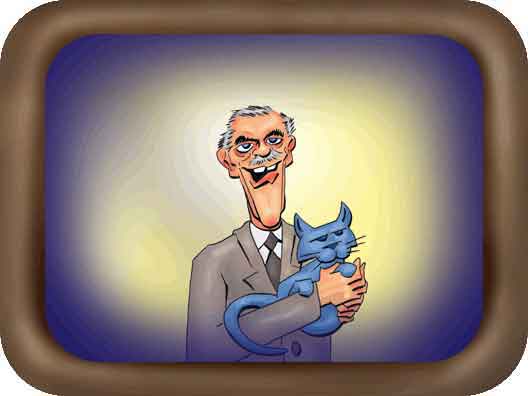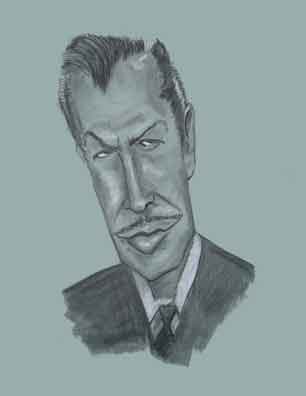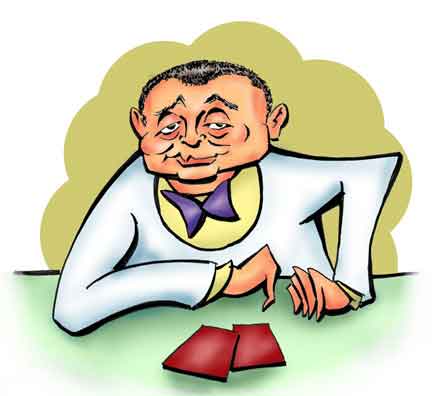Lon Chaney, Jr.
The Indestructible Legacy

Lon Chaney
Son of ...
Everyone knows that Lon Chaney, Jr., was the son of Lon Chaney, Sr., the now iconic horror movie actor of the Silent Era. Lon, Sr. had married a young actress, Francis1 Creighton, and on February 10, 1906, she gave birth to a son in Oklahoma City, Oklahoma.
Footnote
Francis - with an "i" - appears to be the way her name was actually spelled.
To repeat the commonly told story, Creighton was born prematurely, weighed only 2 pounds, and was apparently born dead. But Lon took the baby to the nearby Belle Isle Lake and held him in the frigid water. The shock got Creighton breathing and he later grew to a strapping 6' 3" and 200 pounds.
Although this story sounds a bit pat, Lon's great-grandson did some research and found that the weather and conditions on Creighton's birth date were particularly cold and harsh. Certainly Lon, Jr., told the story himself.
Lon Chaney, Jr. was not born Lon Chaney, Jr. He was christened Creighton Tull Chaney (Creighton was his mom's maiden name). The marriage of Lon, Sr., and Cleva (as Francis was called) was rocky primarily because Lon, Sr., insisted his wife give up her career to be a traditional stay-at-home mom. The arguments became strident and at one point Cleva stormed into a theater where Lon was working and swallowed poison.
Supposedly as soon as Lon, Sr., learned Cleva would survive, he had nothing more to do with her. Their marriage officially ended in 1913 or 1914 (the year varies with the source), and Lon assumed custody of Creighton

...Lon Chaney
As for Cleva, her career was over. The poison had irreparably damaged her voice. She later remarried and lived until 1967.
Creighton's activities for the next few years are not clear but evidently he had little contact with his mother. Another oft-told story is that Lon told his son that Cleva had died. So we can understand that when Creighton later learned his mother was still alive he was angry with his father for some time. That Creighton attended a boarding school certainly didn't cement the father-son relationship either. But in 1915 Lon married a young lady named Helen Hastings, and Creighton moved back home.
Lon, Sr., is associated almost entirely with silent films. But The Jazz Singer was released in 1927, and by 1929 it was clear that the Silent Era was over2. Actors either had to retire or adapt.
Footnote
Once The Jazz Singer became a hit, Warner Brothers announced they would only produce sound films. These, though, were not necessarily "talkies" but also could be silent films with a synchronized sound track. So "sound films" and "talkies" are not exactly the same.
Silent movies didn't completely vanish although the definition of a silent picture became problematic. Charlie Chaplin's Modern Times had no spoken dialog and is for all practical purposes a silent film. However, there is a scene where Charlie sings a song although the lyrics are gibberish. But Modern Times is a silent film by any meaningful definition of the word.
Lon, Sr., himself went "talkie" in 1930 with a remake of his earlier silent picture The Unholy Three. There Lon played a ventriloquist and to the surprise of many, he had an excellent speaking voice. But suddenly, unexpectedly, and hardly a month after the film's release, Lon died.
In the 1957 film The Man of a Thousand Faces Lon, Sr., (played by Jimmy Cagney) succumbs to a throat malignancy while in his home and surrounded by his family. Although he had tried to discourage his son from becoming an actor, Jimmy - or rather Lon, Sr. - now gives his make-up kit to Creighton. Lon, Sr., then writes a "Jr." after his name that is written on the box, and hence passes on the baton.
As is typical for real history, what really happened depends on who does the telling. For one thing, Lon, Sr., died in a hospital not at his home. And though one account agrees that Helen and Creighton were both there, another says that only Helen was present. Yet another researcher stated that Lon, Sr., was attended only by a nurse.
But one thing we do know is that Lon, Sr., did not dub Creighton "Lon Chaney, Jr." When Lon, Sr., died, he had no idea that his son would become an actor. At the time Creighton was working in a water heating business.
Now for the big surprise. Without Lon Chaney, Jr., Lon Chaney, Sr., may very well have fallen into obscurity.
Ha? (To quote Shakespeare.) What was that you said?
Without Lon Chaney, Jr., Lon Chaney, Sr., may very well have fallen into obscurity.
Well, we'd really like to know how you came to that conclusion.
I thought you would as Captain Mephisto said to Sidney Brand. It's very simple really.
By 1930 the talkies had taken over, theaters had been wired for sound, and some studios had quit making silent movies altogether. Even Charlie Chaplin's later movies and some of his most famous - Limelight, The Great Dictator - were talkies.
And with Lon, Sr., having only a single talkie and theaters no longer playing silent pictures, it's entirely conceivable that Lon Sr.'s fame would have faded. True, The Man of a Thousand Faces introduced a younger audience to Lon, and helped keep his memory alive. But this begs the question. If no one was watching his films, why after more than a quarter of a century after his death would a movie about Lon's life be a hit?
Well, that's because as we know young Creighton Chaney did indeed go into acting with his first real film appearing in 19313, the year after his dad died. But he adopted his dad's name reluctantly, and in his early films he was billed under his real name. At that time the memory of Lon, Sr., was still strong, and Lon, Jr., knew that being a scion of a still iconic actor would be too much of a boon not to use. As he put it in a 1935 interview:
Footnote
Strictly speaking, in 1922 when he was sixteen, Creighton was in one of his dad's movies. This was The Trap. But Creighton was neither credited nor did the audiences see him except for his hands. But a bit of trivia for film and television fans is that Lon, Sr.'s, co-star was Alan Hale, the father of Alan Hale (Jr.) who played the Skipper on Gilligan's Island.
I finally gave in, because I have a wife and two children to whom I owe a good living. I tried for three years to make a go of things without capitalizing upon dad's name. But the cards have been stacked against me. If I had only myself to think of, I would battle it out to the end. But I'm getting older every year and I don't think it's right to make my family suffer just so I can fight for a principle.
Although today Lon, Jr. is largely remembered for his work in horror movies - The Wolf Man remains a quintessential classic - he played in a number of genres ranging from crime dramas to westerns. He received some of his best reviews when he played Lenny in "Of Mice and Men". Burgess Meredith (the Penguin on Batman) starred as George.
In 1937 and 1938, the two men had created their roles on Broadway and in 1939 the movie was released. You may read that Lon, Jr.'s, performance was nominated for an Academy Award but sadly that's not true. The picture, though, did receive nominations for Best Picture, Best Musical Score, Best Sound Recording, and Best Black and White Cinematography.
But it was The Wolf Man that pushed Lon, Jr., to iconic fame. His career then lasted through the Golden Age of Films and even stretched well past the rise of television. He appeared in over a hundred movies and over 60 television shows. Everyone knew who Lon Chaney, Jr., was.
However, by the 1950's there were lots of movie goers who had never seen Lon, Sr., or his pictures. Hardly anyone watched silent films any more. And yet if there was a review or write-up about Lon, Jr., inevitably the reporter would mention that he was the son of "famous silent film actor and the Man of a Thousand Faces, Lon Chaney, Sr." So the public might not be watching Lon, Sr.'s, films, but they knew who he was and were well aware of his importance in the film industry.

Boris, with Lon, Jr., one of the Big Four along with ...
The irony is that by the time Lon, Jr., had starred in The Wolf Man he had dropped the "Jr." addendum. Then and later he was almost always billed just as "Lon Chaney".
With Lon, Jr., playing a catholicity of roles, it was inevitable that some would involve a combination of ingredients. One such composite role was the lesser known - and admittedly rather strange - film The Indestructible Man.
In the movie Lon, Jr., plays "Butcher" Benton, a criminal who has been condemned to die in San Quentin. He landed in the Big Q because of a plan devised by a crooked lawyer named Paul Lowe. Paul hired Butcher and two other crooks, Joe Marcelli and "Squeamy" Ellis, to hijack an armored car and steal its $600,000 payload. Butcher was the one to carry away the money and he hid it somewhere in the Los Angeles sewers (Butcher's usual modus). But during the robbery the two guards in the car were killed.
In court Paul defended Butcher. But Butcher wouldn't tell Paul or Joe and Squeamy where the dough was. So Joe and Squeamy turned state's evidence on what we surmise was advice of counsel. They got immunity and Butcher got convicted.
Butcher is convinced it was all a double cross and still refuses to tell Paul where the money is. Paul protests to Butcher with delightful ambiguity that he, Paul, had never worked harder for a client. But evidently tact wasn't something they taught in law classes and just before Butcher's execution, Paul asks "What's the sense of not giving me the money? It's not going to do you any good." Somewhat paradoxically (given the circumstances) Butcher vows he'll "get" Paul and Joe and Squeamy.
Details are filled in via narration by LA Detective Dick Chasen who was assigned to the Benton case. From Detective Dick's voiceover - delivered in terse film noire style - we learn that Butcher goes to the gas chamber and his corpse ends up in the hands of a mad scientist named Dr. Bradshaw.
Old time television buffs will take note that Dr. Bradshaw is played by Robert Shayne. Bob (as he was called) gained his fame for playing Inspector Henderson on the television series The Adventures of Superman starring George Reeves. And Dr. Bradshaw's never-named assistant was played by Joe Flynn, best known for playing Captain Binghamton, the harried commanding officer on Mchale's Navy.
"Mad" is not really a proper description of Dr. Bradshaw, but for some reason he seems to be working outside of the mainstream scientific community. From Detective Dick's narration and the conversation between the doctor and his assistant, we also can figure the corpse was not obtained using proper medical protocol. The assistant just handed over sufficient cash to a mortuary attendant and loaded Butcher into the back of the doctor's station wagon4.
Footnote
This now nearly defunct automobile model was quite popular up through the 1970's. But with the rise of vans, SUV's, and RV's the station wagons went out of favor.
But it's all for the good of science as Dr. Bradshaw and his assistant are trying to find a cure for cancer. Alas, we must also question if the doctor's methods of experimentation are based on good laboratory procedures since part of their tests is to zap Butcher's corpse with 287,000 volts of electricity.
As you'll guess since this is a horror movie, Butcher revives and is now not only alive - although unable to talk - but is also invulnerable. His skin can't be pierced by needles, knives, or bullets, he can yank doors off their hinges, and do a lot more.
Bent on revenge, Butcher notices that Dr. Bradshaw and his assistant keep talking about how they want to study him rather than let him go. So he kills them both. Then he goes after Joe, Squeamy, and Paul. He gets to both Joe and Squeamy and Paul runs to the cops and confesses his part in the deal. But to no avail. Butcher finds him and there's one less sleazy lawyer in LA.
Although the case was officially closed with Butcher's execution, Detective Dick had been trying to tie up the loose ends by finding the money. He manages to talk to Butcher's former girlfriend, Eva, who's now working as - well, we'll call her a dancer. She (sincerely) says she knows nothing about the money and didn't even know Butcher was a bad guy until he was arrested. Detective Chase believes her and finds her sympathetic. And since Butcher's out of the way and Eva's basically a nice girl, he figures he and she can ...
Well, let us continue.
Butcher is finally chased down to the sewers of LA - nowhere near comparable to those of Rome or Paris - to retrieve his stash of cash. Of course by now and with a series of murders and strange clues - when Butcher stole a car the fingerprints on the wheel had been stamped in as if from a machine die - Detective Dick has figured out that Butcher has come back to life and he's invincible.
The big guns - literally - are called in. Butcher ultimately gets hit with a bazooka and blasted with a flame thrower, neither of which stops him but neither do they improve his appearance. Finally he ends up at an electrical power station and gets hit with so much electricity that he's reduced to cinders. So with the case over, Detective Chase and Eva get hitched, and all live happily ever after except for Dr. Bradshaw, his assistant, Joe, Squeamy, Paul, and of course, Butcher.
The Indestructible Man has been almost universally panned. True, it had almost every stereotypical character - the tough, monotone-talking detective, the mad scientist (who wasn't really mad), the timid assistant, the double crossing gangsters, and the crooked lawyer, the obligatory strip club visit by the detective - and of course restoring life by using electricity.
One area of disagreement amongst the critics is whether in his long list of movies, Lon, Jr.'s, acting was good or bad. Some rate him as a talented actor but with limitations that make him most suitable for roles like The Wolf Man and Lenny in Of Mice and Men. But others are far more critical saying that even that performance doesn't compare with those of actors who came later such as John Malkovich.
But oddly enough Lon, Jr.'s, performance in The Indestructible Man gainsays the more censorious critics. True, for virtually all of the movie, Lon, Jr., says nothing and wanders around looking alternatively perplexed, diabolical, and pleased. It's only in the first scene that he has any dialog. But there Lon, Jr., is completely convincing and the delivery is as you'd really expect a murderer to talk - particularly when he realizes his own lawyer is in cahoots against him.

... Vincent ...
Critics point out that The Indestructible Man was filmed when Lon, Jr.'s, career was on the wane. This was in 1956. But two years later his career got the proverbial shot in the arm when the first issue of Famous Monsters of Filmland hit the stands5. The editor, Forest J. Ackerman, was a long time horror fan and beginning with the first issue featured articles and photos of Lon, Jr6., including still shots from Abbott and Costello Meet Frankenstein. Lon, Jr., was soon included as one of the Big Four of Horror along with Vincent Price, Peter Lorre, and Boris Karloff. All of their movies were frequent features on the late night movies7.
Footnote
It's an instructive exercise to peruse early issues of the original Famous Monsters of Filmland, and you'll understand why so many people would read magazines in those days. Today the few remaining print magazines have minuscule text sandwiched between nigh on wall-to-wall ads, often with more space on the pages devoted to advertisement that to the actual article.
But in the early magazines - where often the main revenue was from subscriptions and newsstand sales - you could go through page after page and encounter no ads at all. The advertisements were relegated to their own pages often at the end of the issue. In other words, you could actually read the magazines.
Footnote
Of course Famous Monsters of Filmland also played no little part in preserving the memory and films of Lon Chaney, Sr., as well. Forrest was one of his biggest fans, and although virtually none of his readers had ever seen one of Lon, Sr.'s, films, there was no dearth of issues with articles and photographs that paid tribute to the elder Chaney and his films.
Footnote
With the rise of the home video, the Late Night Movie has become a largely moribund entertainment genre. Usually scheduled for late Friday or Saturday nights, the time slots were perfect for showing horror movies to nervous teenagers when their parents were out.
As television squeezed out the movies and radio as America's favorite sedentary entertainment, Lon, Jr., began appearing on the small screen. Among the series (many now forgotten) where he appeared in a guest slot were The Rifleman (starring Chuck Connors), The Deputy (one of Henry Fonda's rare TV series), Klondike (with Ralph Taeger and James Coburn), Tombstone Territory (Pat Conway and Richard Eastham), Climax! Theater (an anthology series), Lawman (starring John Russell), Surfside 6, General Electric Theater, Wanted: Dead or Alive (which made a star of Steve McQueen), Border Patrol, Have Gun - Will Travel (a hit series starring Richard Boone), Adventures in Paradise, Route 66 (with a pre-Adam 12 Martin Milner), The Rough Riders, 13 Demon Street, Telephone Time, Cavalcade of America, The Red Skelton Hour (a comedy variety show), Stagecoach West, Cosmopolitan Theatre, Hawkeye and the Last of the Mohicans, Bat Masterson (starring Gene Barry), Target, Johnny Ringo, Studio 57, Tales of Tomorrow, Wagon Train (with Ward Bond and Robert Horton), The Whistler, Zane Grey Theater, Rawhide (with Clint Eastwood in his most notable early role), The Texan, Schlitz Playhouse, The Colgate Comedy Hour, Lock Up, Pistols 'n' Petticoats, Empire (with a young Ryan O'Neal and Charles Bronson), and The Monkees.

... and Peter.
It was on The Monkees we see Lon, Jr., in a quite atypical performance. There the musical quartet ends up in an Old West ghost town and meet a not-too-smart bank robber named Lenny (Lon, Jr.) and his smarter partner, George (played by an uncredited Len Lesser). The satire is obvious. George and Lenny were waiting for "The Big Man" to arrive so they could split up the loot from their last robbery. Then when the Big Man finally showed up it was a tough talking lady played by Rose Marie. Of course, in the end the bad guys (and gal) get hauled off to jail and the Monkees go on their way. All in all, Lon, Jr.'s comedic performance was pretty good.
What was Lon, Jr., really like? Well, as with everyone else you get different opinions. Some found him - as often is the case with people who play bad guys - a kind and gentle man and generally liked by his co-workers8. But others remember him as a heavy boozer whose drinking could easily get out of hand and caused major problems. Lon, Jr., later developed throat cancer (he did smoke a lot) but ultimately he recovered. His last movie was filmed in 1969 and he died in 1973 at age 67.
Footnote
Another bad movie guy who was really congenial was Harold Sakata who played Oddjob in the James Bond movie Goldfinger. Tommy Bond, "Butch" on Our Gang and The Little Rascals, was also the opposite of his on-screen tough, bully character.
If you ever visit the Forest Lawn Memorial Park you can wind your way to the Great Mausoleum, Sanctuary of Meditation, Niche C-6407. There you'll find the unmarked crypt of Lon Chaney.
Lon Chaney, Sr., that is.
And Lon, Jr.? Well, you won't find his grave there or anywhere around Hollywood. No, he wasn't buried elsewhere nor was he cremated and his ashes scattered. Instead, he donated his body to science and ended up being dissected by medical students at USC.
References
Lon Chaney, Jr.: Horror Film Star, 1906 - 1973, Don Smith, McFarland, 1996.
"Lon Chaney, Jr.: Of Mice and Werewolves", Lloyd's Beware of the Blog.
"Lon Chaney, Jr.", Internet Movie Data Base.
"Lon Chaney, Jr.: Actor, Film Actor (1906 - 1973)", Biography.com.
The Trap, Lon Chaney (Actor), Alan Hale (Actor), Creighton Chaney (Actor, Uncredited), Robert Thornby (Director), Lon Chaney (Writer), Lucien Hubbard (Writer), George Hull (Writer), Irving Thalberg (Writer), Universal, 1922, Internet Movie Data Base.
"The Indestructible Man", 1000 Misspent Hours, Scott Ashlin.
"Lon Chaney, Jr.", Find A Grave, 2000.
"The Best Movies of 1957", Ranker Film.
"Secrets from Lon Chaney's Oklahoma Odyssey", Sam Henderson, Daily Oklahoman, November 14, 1982, Archived at NewsOK.
"Why Did Chaplin Make "Modern Times" as a Silent Film, a Decade After the Invention of Talkies", Jeff Saporito, The Take, Screen Prism, September 14, 2015
"Oklahoma's Wolf Man: Lon Chaney Jr.'s State Roots To Be Explored in Book", Jimmie Tramel, Tulsa World, October 30, 2016.
The Indestructible Man, Lon Chaney (Jr.) (Actor), Max Showalter (Actor), Marian Carr (Actor), Ross Elliott (Actor), Ken Terrell (Actor), Robert Shayne (Actor), Marvin Press (Actor , Not credited), Jack Pollexfen (Director), Vy Russell (Writer), Sue Dwiggins (Writer), C.G.K. Productions, 1956, Internet Movie Data Base.
The Monkees in a Ghost Town, Davy Jones (Actor), Micky Dolenz (Actor), Michael Nesmith (Actor), Peter Tork (Actor), Lon Chaney (Jr.) (Actor), Len Lesser (Actor, Uncredited), Rose Marie (Actor), James Frawley (Director), Robert Schlitt (Writer), Peter Meyerson (Writer), Screen Gems, 1966, Internet Movie Data Base.